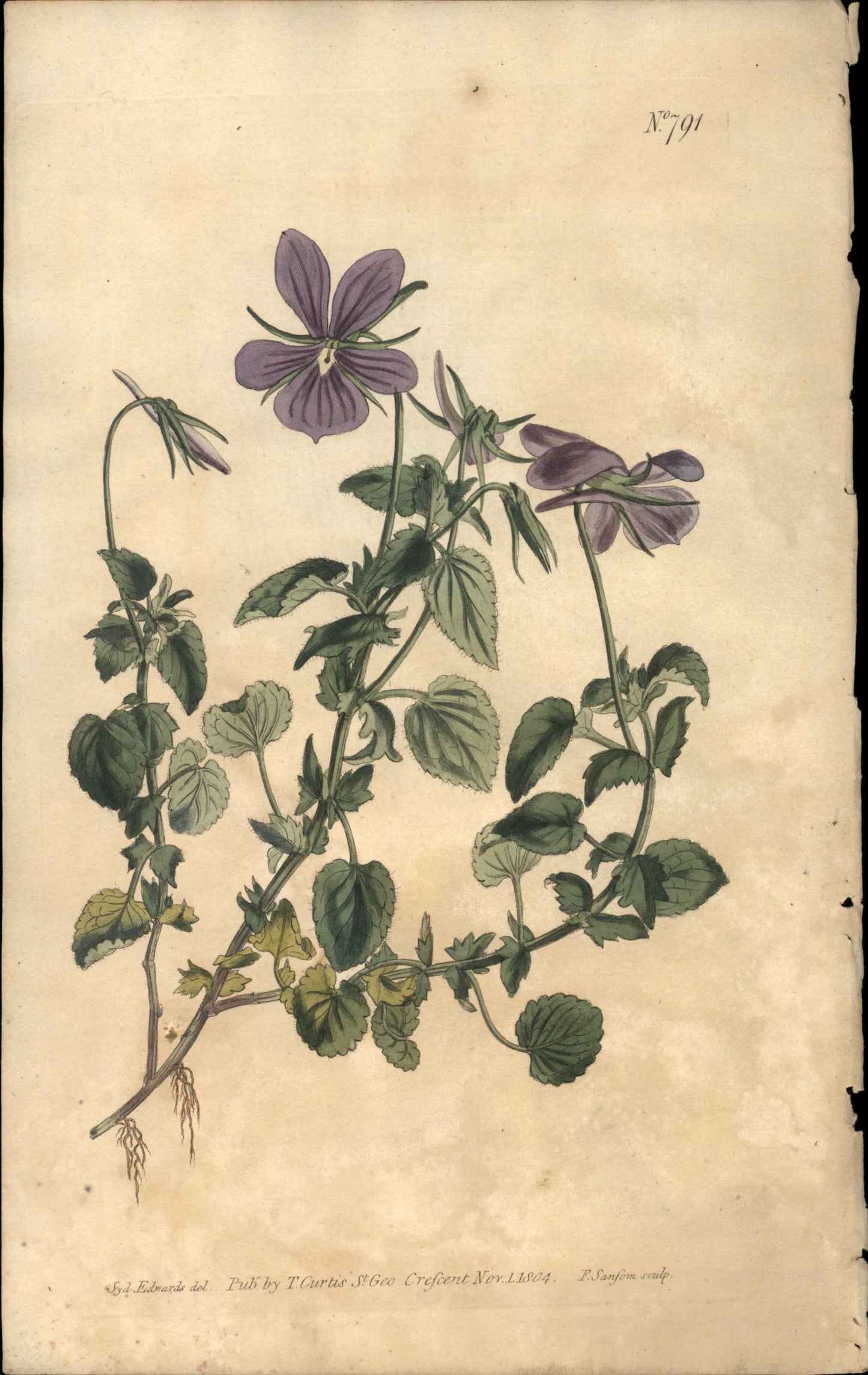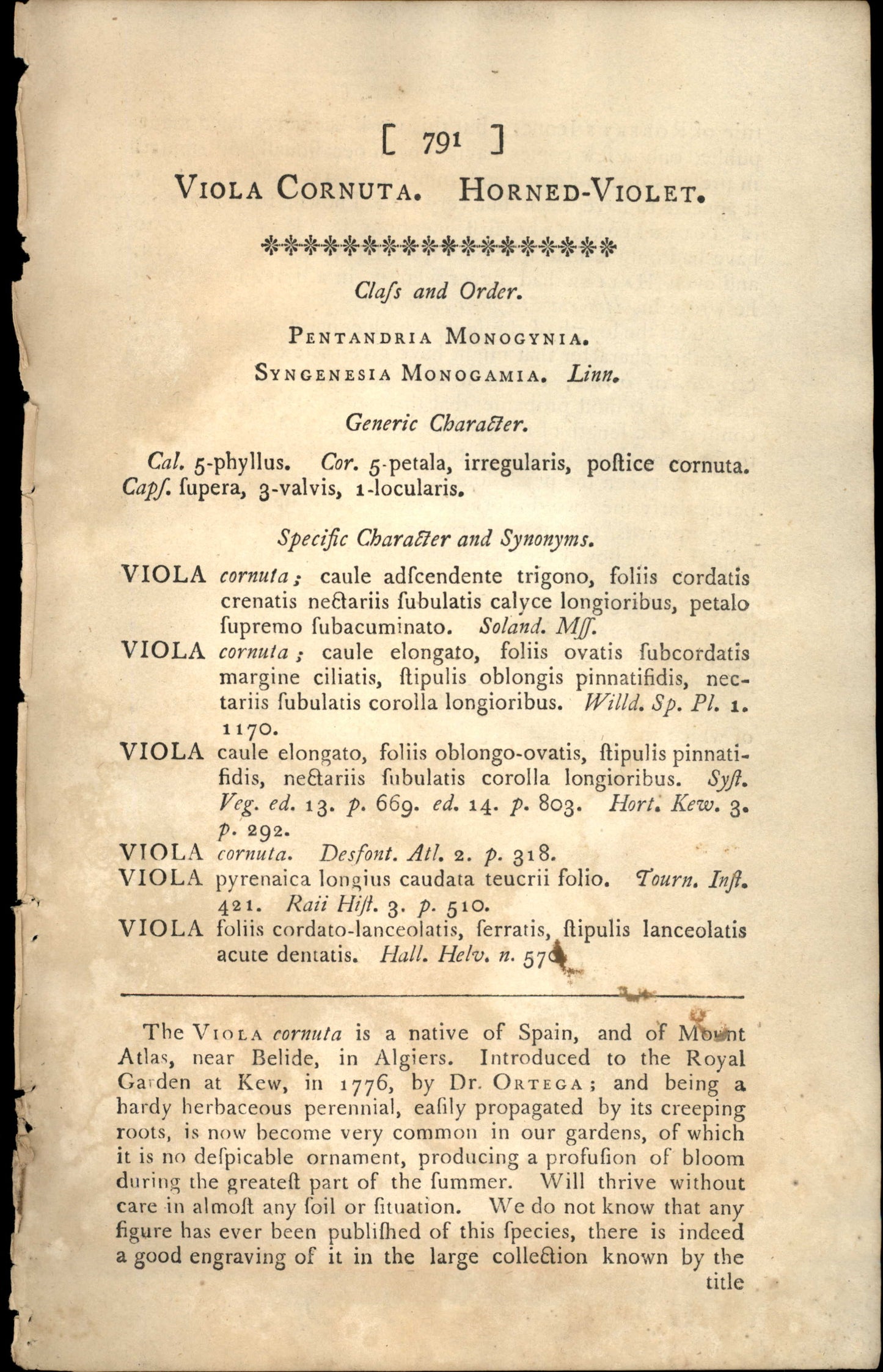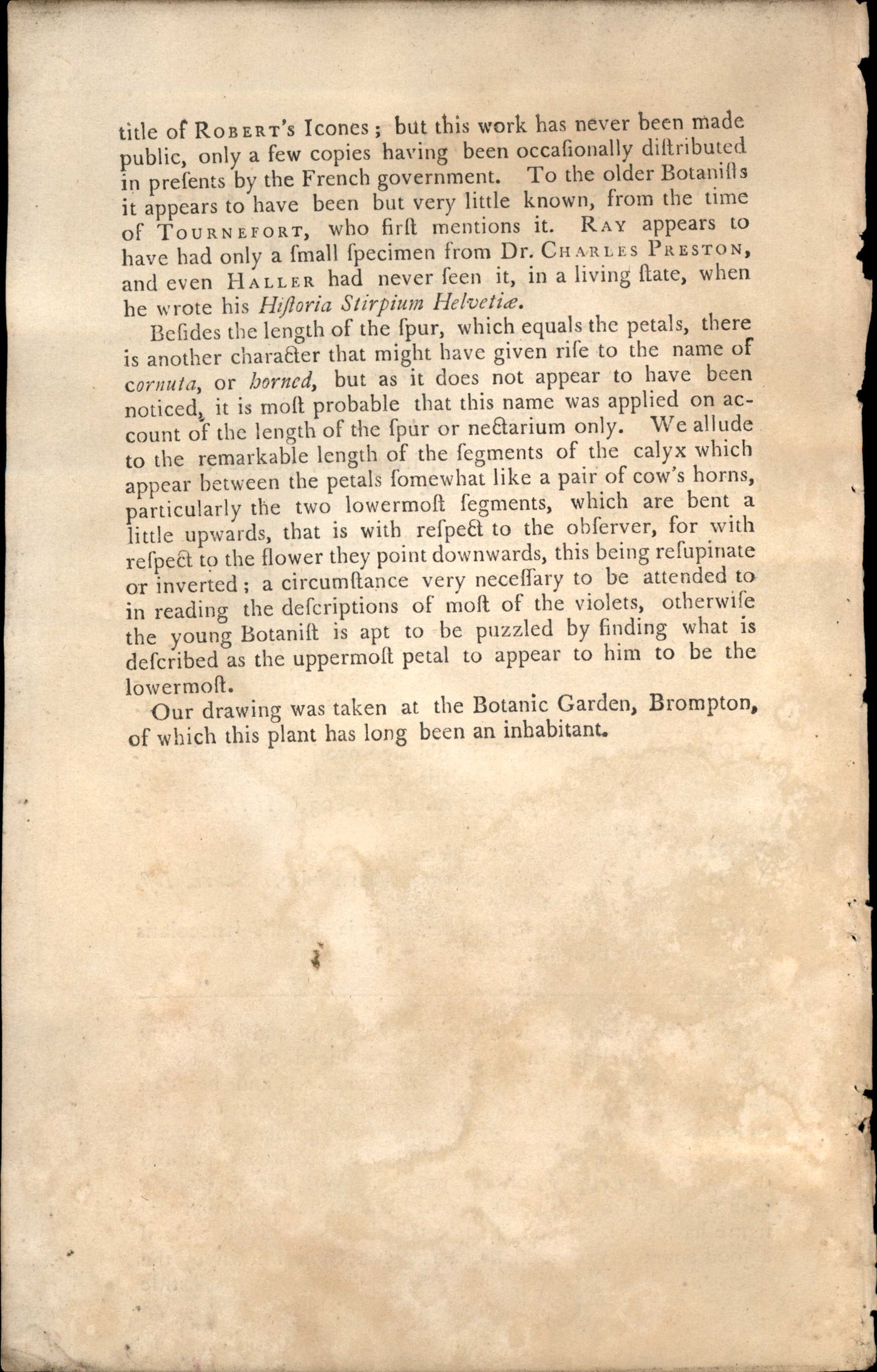Curtis Botanical Magazine
Plate 791 - Viola Cornuta
Plate 791 - Viola Cornuta
Couldn't load pickup availability
Plate 791
Classification: PENTANDRIA MONOGYNIA
Publication Date: Nov.1.1804
Description:
Botanical Description
VIOLA cornuta is a native of Spain, and of Mount Atlas, near Belide, in Algiers. Introduced to the Royal Garden at Kew, in 1776, by Dr. ORTEGA; and being a hardy herbaceous perennial, eafily propagated by its creeping roots, is now become very common in our gardens, of which it is no defpicable ornament, producing a profufion of bloom during the greateft part of the fummer. Will thrive without care in almoft any foil or fituation. We do not know that any figure has ever been published of this species, there is indeed a good engraving of it in the large collection known by the title --- CBM-ToList-791t.
Complete Botanical Text (Cleaned)
N°791 syd Edwards del Pub by T.Curtis sGeo Crefcent Nov.1.1804.
F.Sansom sculp [ 791 ] VIOLA CORNUTA.
HORNED-VIOLET. **************** Class and Order.
PENTANDRIA MONOGYNIA. sYNGENESIA MONOGAMIA.
Linn.
Generic Character.
Cal. 5-phyllus.
Cor. 5-petala, irregularis, poftice cornuta.
Capf. fupera, 3-valvis, 1-locularis. specific Character and synonyms.
VIOLA cornuta; caule adfcendente trigono, soliis cordatis crenatis nectariis fubulatis calyce longioribus, petalo fupremo fubacuminato.
Soland.
M.
VIOLA cornuta; caule elongato, soliis ovatis fubcordatis margine ciliatis, ftipulis oblongis pinnatifidis, nec- tariis fubulatis corolla longioribus.
Willd. sp.
Pl. 1. 1170.
VIOLA caule elongato, soliis oblongo-ovatis, ftipulis pinnati- fidis, nectariis fubulatis corolla longioribus. syst.
Veg. ed. 13. p. 669. ed. 14. p. 803.
Hort.
Kew. 3. p. 292.
VIOLA cornuta.
Dessont.
Atl. 2. p. 318.
VIOLA pyrenaica longius caudata teucrii solio.
Tourn.
Inft. 421.
Raii Hift. 3. p. 510.
VIOLA soliis cordato-lanceolatis, ferratis, ftipulis lanceolatis acute dentatis.
Hall.
Helv. n. 57 The VIOLA cornuta is a native of spain, and of Mount Atlas, near Belide, in Algiers.
Introduced to the Royal Garden at Kew, in 1776, by Dr.
ORTEGA; and being a hardy herbaceous perennial, easily propagated by its creeping roots, is now become very common in our gardens, of which it is no defpicable ornament, producing a profusion of bloom during the greateft part of the summer.
Will thrive without care in almost any soil or situation.
We do not know that any figure has ever been published of this species, there is indeed a good engraving of it in the large collection known by the title title of ROBERT's Icones; but this work has never been made public, only a few copies having been occafionally diftributed in presents by the French government.
To the older Botanifls it appears to have been but very little known, from the time of TOURNEFORT, who first mentions it.
RAY appears to have had only a fmall specimen from Dr.
CHARLES PREsTON, and even HALLER had never seen it, in a living state, when he wrote his Hiftoria stirpium Helvetia.
Befides the length of the fpur, which equals the petals, there is another character that might have given rife to the name of cornuta, or borned, but as it does not appear to have been noticed, it is most probable that this name was applied on ac- count of the length of the fpur or nectarium only.
We allude to the remarkable length of the segments of the calyx which appear between the petals somewhat like a pair of cow's horns, particularly the two lowermost segments, which are bent a little upwards, that is with respect to the observer, for with respect to the flower they point downwards, this being refupinate or inverted; a circumftance very necessary to be attended to in reading the descriptions of most of the violets, otherwife the young Botanift is apt to be puzzled by finding what is described as the uppermost petal to appear to him to be the lowermost.
Our drawing was taken at the Botanic Garden, Brompton, of which this plant has long been an inhabitant
Raw OCR Text (Original)
N°791 syd Edwards del Pub by T.Curtis sGeo Crefcent Nov.1.1804. F.Sansom sculp. [ 791 ] VIOLA CORNUTA. HORNED-VIOLET. **************** Class and Order. PENTANDRIA MONOGYNIA. sYNGENESIA MONOGAMIA. Linn. Generic Character. Cal. 5-phyllus. Cor. 5-petala, irregularis, poftice cornuta. Capf. fupera, 3-valvis, 1-locularis. specific Character and synonyms. VIOLA cornuta; caule adfcendente trigono, soliis cordatis crenatis nectariis fubulatis calyce longioribus, petalo fupremo fubacuminato. Soland. M. VIOLA cornuta; caule elongato, soliis ovatis fubcordatis margine ciliatis, ftipulis oblongis pinnatifidis, nec- tariis fubulatis corolla longioribus. Willd. sp. Pl. 1. 1170. VIOLA caule elongato, soliis oblongo-ovatis, ftipulis pinnati- fidis, nectariis fubulatis corolla longioribus. syst. Veg. ed. 13. p. 669. ed. 14. p. 803. Hort. Kew. 3. p. 292. VIOLA cornuta. Dessont. Atl. 2. p. 318. VIOLA pyrenaica longius caudata teucrii solio. Tourn. Inft. 421. Raii Hift. 3. p. 510. VIOLA soliis cordato-lanceolatis, ferratis, ftipulis lanceolatis acute dentatis. Hall. Helv. n. 57 The VIOLA cornuta is a native of spain, and of Mount Atlas, near Belide, in Algiers. Introduced to the Royal Garden at Kew, in 1776, by Dr. ORTEGA; and being a hardy herbaceous perennial, easily propagated by its creeping roots, is now become very common in our gardens, of which it is no defpicable ornament, producing a profusion of bloom during the greateft part of the summer. Will thrive without care in almost any soil or situation. We do not know that any figure has ever been published of this species, there is indeed a good engraving of it in the large collection known by the title title of ROBERT's Icones; but this work has never been made public, only a few copies having been occafionally diftributed in presents by the French government. To the older Botanifls it appears to have been but very little known, from the time of TOURNEFORT, who first mentions it. RAY appears to have had only a fmall specimen from Dr. CHARLES PREsTON, and even HALLER had never seen it, in a living state, when he wrote his Hiftoria stirpium Helvetia. Befides the length of the fpur, which equals the petals, there is another character that might have given rife to the name of cornuta, or borned, but as it does not appear to have been noticed, it is most probable that this name was applied on ac- count of the length of the fpur or nectarium only. We allude to the remarkable length of the segments of the calyx which appear between the petals somewhat like a pair of cow's horns, particularly the two lowermost segments, which are bent a little upwards, that is with respect to the observer, for with respect to the flower they point downwards, this being refupinate or inverted; a circumftance very necessary to be attended to in reading the descriptions of most of the violets, otherwife the young Botanift is apt to be puzzled by finding what is described as the uppermost petal to appear to him to be the lowermost. Our drawing was taken at the Botanic Garden, Brompton, of which this plant has long been an inhabitant.
Original botanical print from Curtis's Botanical Magazine
Share







